
Grand Canyon National Park is very large, and very diverse; it contains 1.2 million acres of land and over 1,750 species of plants. Yet within this huge area containing ecosystems ranging from forest to desert, there is only one federally-listed endangered plant: sentry milk-vetch (Astragalus cremnophylax var. cremnophylax). Sentry milk-vetch is not only endangered, it is also endemic, meaning that Grand Canyon National Park is the only place in the world that this plant lives. The species name cremnophylax means 'gorge watchman;' a suitable name for a little plant that grows only on the edge, watching over Grand Canyon. A member of the pea family (Fabaceae), sentry milk-vetch is a tiny, perennial herb that grows only in shallow soil pockets in cracks and crevices of the Kaibab Limestone, within 25 feet of the rim of Grand Canyon. 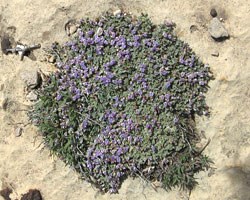
Like many rare plants with very specific habitat requirements, sentry milk-vetch is threatened by habitat loss, climate change, and drought. The sentry milk-vetch population near Maricopa Point was fenced in 1990 after scientists discovered that the plants were unable to withstand inadvertent trampling by visitors seeking to enjoy views of the canyon.
Biology and History
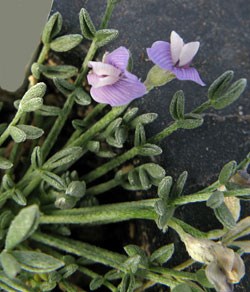
Even though sentry milk-vetch has been known to science for over 100 years, very little is known about its life history. Current research by Grand Canyon National Park's Division of Science and Resource Management and the Arboretum of Flagstaff is providing significant insights into this endangered plant. Typically, milk-vetch seeds ripen in May, a month after peak flowering. Seeds appear to fall and germinate quite close to the parent plant, but may be dispersed by gravity, wind and surface water. Even with the large number of flowers and seeds each plant produces, few seeds germinate and even fewer seedlings survive to maturity. Hence, the species is extremely vulnerable to extinction. 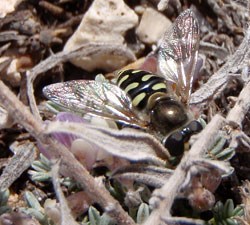
The main pollinators for sentry milk-vetch are Mason bees (Osmia species), and hoverflies (family Syrphidae), while ants, flies and other species have been observed visiting flowers and likely contribute to pollination. 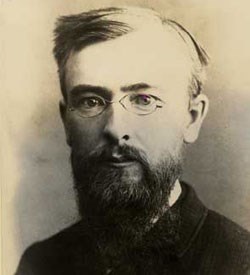
Archives of the Jepson Herbarium, However, only 40 years later another noted botanist, Rupert Barneby, determined that the plant was "of great rarity" in the park. The decline of the species may be in part attributable to the significant rise in visitation to the Grand Canyon in the intervening years. In 1903, sixteen years before Grand Canyon became a national park, visitation was very low: the Grand Canyon Railway had been completed only two years previously and there were very few permanent buildings on the canyon's rim. By 1947, when Barneby visited, more than 600,000 people visited Grand Canyon each year, and many structures, roads and walkways had been constructed on the rim.
Current Status 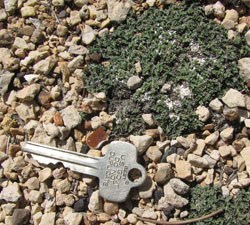
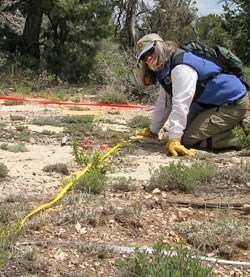
NPS photo by Allyson Mathis The risk of extinction is elevated because the sentry milk-vetch only exists at Grand Canyon in a few small populations. With the plant's only habitat in a tiny, narrow band at the edge of the canyon's rim, sentry milk-vetch has no place else to go in cases of persistent drought or extreme weather events.
The Division of Science and Resource Management at Grand Canyon National Park has partnered with the U.S. Fish and Wildlife Service, the Arboretum at Flagstaff, and the Grand Canyon Association, Grand Canyon National Park's official nonprofit partner, to initiate a dynamic conservation program designed to preserve, protect and facilitate the recovery of this endangered species.
In 2006, the U.S. Fish and Wildlife Service prepared a recovery plan for sentry milk-vetch. The ultimate objective of the recovery plan is to remove the sentry milk-vetch from the federal list of Threatened and Endangered Species. The plan outlines science-based criteria for the number and size of populations that must exist in order for the species to be considered recovered. According to the recovery plan, the plant will be downlisted to threatened status when there are four established sentry milk-vetch populations which each contain 1,000 individuals that are stable or increasing in size over a thirty-year period. The sentry milk-vetch will be considered recovered and eligible to be delisted, when there are eight populations which each contain over 1,000 individuals and the populations are protected from threats in perpetuity.
Recovery Program 
In 2008, the National Park Service rehabilitated Hermit Road [link to CS06]. The parking lot at Maricopa Point was removed in order to expand the habitat available for the sentry milk-vetch population. Most of the former parking lot was restored with other native plant species, but a small area was set aside for habitat restoration and sentry milk-vetch re-introduction trials, under the direction of park horticulturalist Janice Busco.

Additionally, Grand Canyon National Park's Division of Facility Management constructed a new 200 square-foot passive solar greenhouse for sentry milk-vetch. 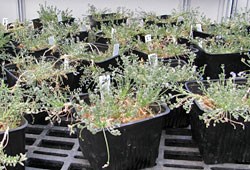
The greenhouse population began flowering in February 2010, which marked a major step forward in the recovery effort for this tiny plant. 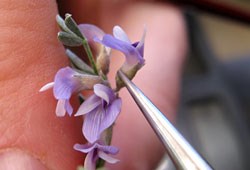
To hand-pollinate, researchers squeeze each flower open with tweezers, retrieve golden pollen from its stamens with a fine paintbrush, then repeat this action on another flower. Seeds produced by the ex situ population can be used to grow additional plants to be used in restoration efforts in the wild. 
Vegetation Program crews carefully removed fill material by hand to expose the limestone bedrock without damaging its integrity. They then filled in shallow pockets and cracks in the limestone with local soil to prepare the site for planting.
Five of the first greenhouse-grown sentry milk-vetch plants went into the ground in July 2010 and have survived to this date. A small seeding trial using wild collected seeds was conducted in spring 2011. Once resource managers knew they could successfully plant and seed sentry milk-vetch at Maricopa Point, they were ready for the next major step in the recovery efforts.
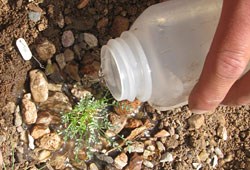
In the restoration site, seeds require even more protection from sun, wind and rain. They were covered with a shallow dusting of native soil, surrounded by a protective collar, and veiled with a small piece of landscape fabric that lets in air, sunlight, and water and keeps out wind and insect pests. 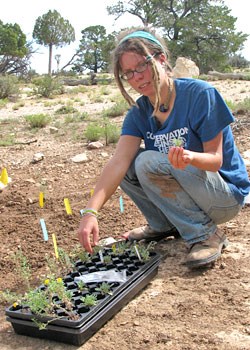
NPS PHOTO BY ALLYSON MATHIS By mid-October 2011, 74 of the 80 plants are alive and well on their way to becoming able to live on their own in their harsh natural habitat. At least 70% of the seeds germinated. The Division of Science and Resource Management plans to augment the Maricopa Point population in 2012. Further recovery actions will occur after the park develops a comprehensive step-by-step plan that outlines the specific actions that park needs to take in order to reach the species recovery plan goals.
Since the inception of the National Park Service in 1916, the agency has followed its congressional mandate to preserve natural resources unimpaired for the enjoyment, education and inspiration of this and future generations. The ecosystems found in Grand Canyon National Park evolved over millennia, and each organism, no matter how small, has an important role in the contemporary environment. Biologists at Grand Canyon, through their efforts to safeguard the sentry milk-vetch, are striving to fulfill the critical goal of preserving the unparalleled biodiversity of the canyon ecosystems. With their success, the presence of this beautiful and unique plant at Grand Canyon will be assured, not only for the enjoyment of future generations, but also for its intrinsic value.
|
Last updated: September 16, 2023
